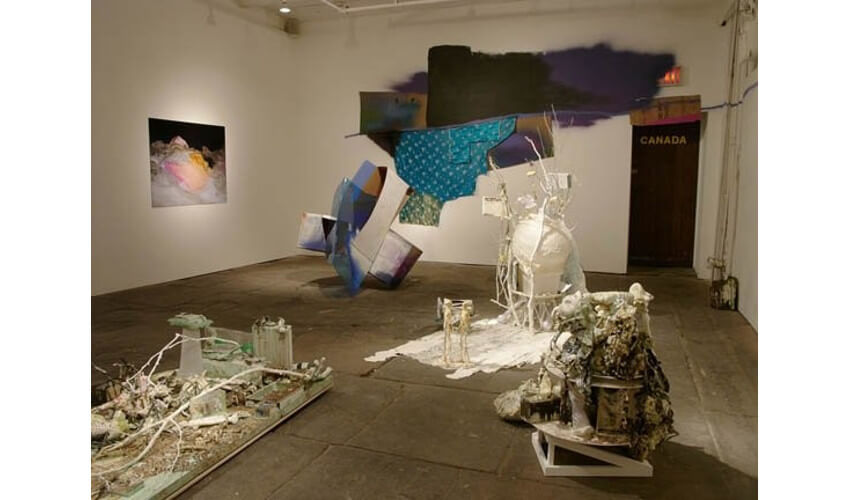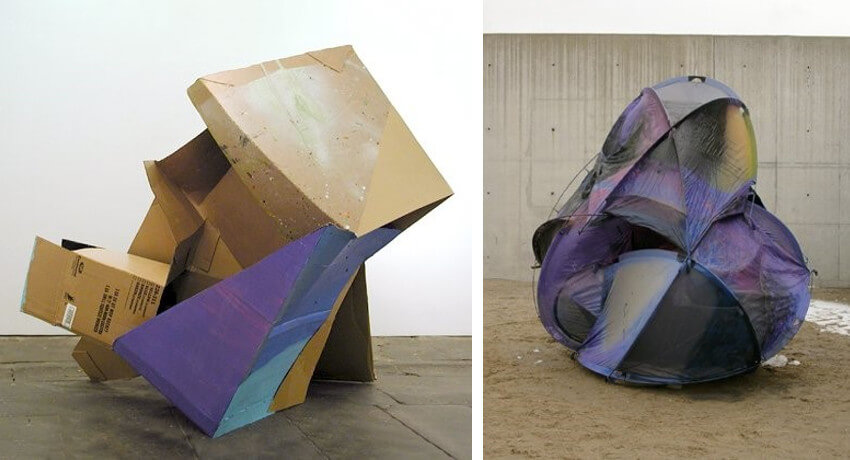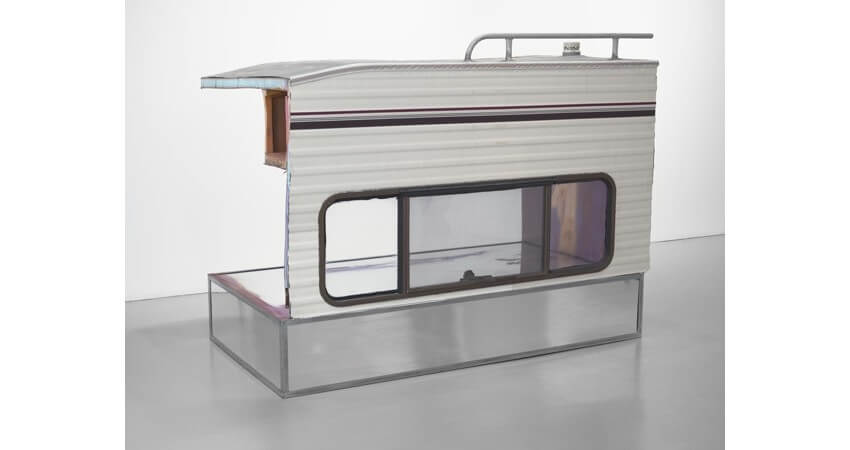
The Curious Sculptures of Sarah Braman
The objects Sarah Braman creates are uncanny. Assembled from a range of found consumer products, industrial materials and traditional art mediums, they are instantly familiar, but also somehow alien. Each entity Braman coaxes into existence confronts us as part artifact and part being: an individual, yet also obviously part of a larger family, or species. Assembled from the visual detritus of our built universe, they happily invite us into their group. Their playful forms engage us with anthropomorphic object-hood, resembling pitiful-but-beloved inhabitants of some Island of Misfit Transformers. Once immersed in their presence we let down our guard. And that is when they tear us open to expose our vulnerabilities: our nostalgia; our materialism; and our secret shame at the odd ways we rearrange our world in search of comfort. We might disengage and talk about the work Braman does in formal aesthetic terms, focusing on elements like geometry, color, light and space. But her accomplishment is that her work demands more. It extracts memories. It evokes feeling. It starts conversations—between viewers, between the present and the past, between the natural and the synthetic, between the objective and the subjective, and between the figurative and the abstract.
The Spoils of War
The recent work of Sarah Braman is among her most refined. It is eloquent and direct—the product of an artist with big ideas and a firm grasp on how to communicate them. Looking back earlier in her career it is fascinating to see the roots of her aesthetic, and the proto-manifestations of what she calls her “monuments to everyday life.” In 2005, Braman participated in a collaborative exhibition called Seven Thousand Years of War, at CANADA, an artist run gallery on the Lower East Side of New York. She contributed a sculptural assemblage and a collaged wall element to the show. She also collaborated with photographer Phil Brauer by spray painting piles of snow encountered in a commercial parking lot. Through his camera, Brauer contextualized the piles as glowing, nightmarish mountain-scapes. Also in the exhibition were several all-white sculptures by Aidas Bareikis resembling post-apocalyptic heap-architecture reclaimed by nature.
The title of the exhibition invites the question: “What war?” The work seems to answer, “The war between culture and nature.” It was roughly 7000 years ago that our Neolithic ancestors embarked on what we could loosely call civilization. That is when the wheel and written language were invented, marking the start of processes that led to, among other things, accumulations of consumer waste, cardboard, spray paint, photography, plastic, etc. The work certainly speaks to the engagement between humanity and the natural world. But no cynicism was evident in the work Braman contributed. It expressed confidence, as if this war is not unequivocally a bad thing; it is just a thing. What we feel about it is personal, not universal.
 Seven Thousand Years of War, 2005, Installation View, CANADA New York, © CANADA, Sarah Braman, Phil Brauer, Aidas Bareikis
Seven Thousand Years of War, 2005, Installation View, CANADA New York, © CANADA, Sarah Braman, Phil Brauer, Aidas Bareikis
Accumulation and Objectivity
The aesthetic Braman has since developed is one of found objects, accumulation and aesthetic intervention. It is not at all the same expression associated with Modernist artists of the past who developed similar positions, such as Robert Rauschenberg or Arman. Rauschenberg used found objects in such a way that they retained their original essence. His famous Monogram, which features a goat with a tire around its belly, expresses full goat-ness and full tire-ness. It is an assemblage of found objects thoroughly intervened with, but we are aware of its individual parts. Arman, in his accumulations, reveled in the sameness inherent in similar objects. His horn accumulations evoke only the thought of horns. His clock accumulations make us think, “Clocks.”
 Sarah Braman - Second Surrender, 2002, Cardboard, acrylic paint (left) and Installation View from PS1 Greater New York, 2005, MoMA PS1, © Sarah Braman
Sarah Braman - Second Surrender, 2002, Cardboard, acrylic paint (left) and Installation View from PS1 Greater New York, 2005, MoMA PS1, © Sarah Braman
Braman accomplishes something different with her work. Her creations take on personalities, as though the coming together of their parts was inevitable; elements that were always meant to combine have configured themselves into something novel. She has a knack for expressing the character of materials and objects, not in a quaint way but simply in a way that animates them. Be it cardboard, Plexiglas, part of a car, a piece of furniture, a door, a tent or a stump, she collaborates with materials rather than enforcing a point of view on them. Their hidden truth manifests. It is lively, and we relate.
 Sarah Braman - You Are Everything, 2016, Installation view at Mitchell-Innes & Nash, NY, © Sarah Braman, courtesy Mitchell-Innes & Nash, NY
Sarah Braman - You Are Everything, 2016, Installation view at Mitchell-Innes & Nash, NY, © Sarah Braman, courtesy Mitchell-Innes & Nash, NY
Emotional Design
Much of the power in her work comes from the ability Braman has to choose source materials that convey emotion. Consider Coffin, a sculptural assemblage incorporating a dismembered section of a recreational vehicle. The “camper chunk” will not evoke the same personal reaction from every viewer, but it undoubtedly touches a memory in the mind of everyone who sees it. The work welcomes personal contemplation, while its design allows objective interpretation on the grounds of color, form, light and space.
Perhaps the most essential element Sarah Braman captures in her work is curiosity. Each object draws us in towards it. It asks to be examined. It offers us familiarity but then asks us to look beyond what we know. Some works even allow viewers to climb inside of them. Physically inhabiting a sculpture breaks down a barrier. It makes something abstract into something utilitarian. It invites curiosity on another level by sparking questions not only about the work, but also about what the nature of all art might be.
 Sarah Braman - Coffin, 2011, Camper chunk, steel, Plexiglas and paint, © Sarah Braman, courtesy Mitchell-Innes & Nash, NY
Sarah Braman - Coffin, 2011, Camper chunk, steel, Plexiglas and paint, © Sarah Braman, courtesy Mitchell-Innes & Nash, NY
Featured image: Sarah Braman - Space Talk, 2016, Tree stump, steel and glass, © Sarah Braman, courtesy Mitchell-Innes and Nash
All images used for illustrative purposes only
By Phillip Barcio






